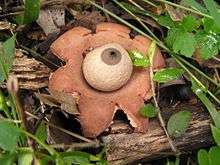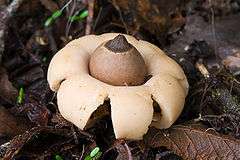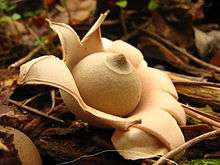Geastrum saccatum
Geastrum saccatum, commonly known as the rounded earthstar,[1] is a species of mushroom belonging to the genus Geastrum. It has a worldwide distribution and is found growing on rotting wood. It is considered inedible by mushroomers because of its bitter taste. It is a common mushroom, but collections are at their peak during late summer. The opening of the outer layer of the fruiting body in the characteristic star shape is thought to be due to a buildup of calcium oxalate crystals immediately prior to dehiscence. G. saccatum is distinguished from other earthstars by the distinct circular ridge or depression surrounding the central pore. In Brazil, its common name translates to "star of the land".[2]
| Geastrum saccatum | |
|---|---|
 | |
| Scientific classification | |
| Kingdom: | |
| Phylum: | |
| Class: | |
| Subclass: | |
| Order: | |
| Family: | |
| Genus: | |
| Species: | G. saccatum |
| Binomial name | |
| Geastrum saccatum | |
| Geastrum Saccatum | |
|---|---|
float | |
| glebal hymenium | |
| no distinct cap | |
| spore print is brown | |
| ecology is saprotrophic | |
| edibility: inedible | |
Description

The immature fruiting body is 0.6 to 2.5 centimetres (0.24 to 0.98 in) in diameter and 0.8 to 1.5 centimetres (0.31 to 0.59 in) tall. Initially, the fruiting body is egg-shaped–similar in appearance to puffballs–and has strands of mycelia (rhizomorphs) at the base that attach it to the growing surface. The 'skin,' or peridium, is composed of two separate layers: the outer layer (exoperidium), which is a golden tan to yellowish-brown color, separates away from the inner basidiocarp and splits into several rays that curve backward (recurve) to the base. The mushroom is 2 to 5 centimetres (0.79 to 1.97 in) in diameter after the rays have expanded. Unlike some other members of the genus Geastrum (such as Geastrum fornicatum) the arms do not push the basidiocarp off the ground; rather, it lies flat. The inner spore-bearing basidiocarp is 0.5 to 2 centimetres (0.20 to 0.79 in) broad, and has a central pore surrounded by a circular dull-brown apical disc; the disc is distinctly ridged or depressed.[1] The inside of the interior sphere is white when young, but matures into a mass of brown, powdery spores mixed with thick-walled fibres known as capillitium.[3] The species is inedible.[4]

Habitat and distribution
Geastrum saccatum is saprobic, and grows scattered or clustered together in leaf litter of humus, usually in late summer and fall. It has a cosmopolitan distribution, and is well adapted to tropical regions.[2] It is common in Hawaiian dry forests.[5] The species has been collected in the United States, Argentina, Uruguay, Brazil, Canada, China, Congo, Cuba, Mexico, Panama, South Africa, West Africa, Tanzania, and Tobago.[6]
Mechanism of dehiscence
A study has shown that the formation of calcium oxalate crystals on the hyphae that form the endoperidial layer of the basidiocarp is responsible for the characteristic opening (dehiscence) of the outer peridial layers.[7] Calcium oxalate is a common compound found in many fungi,[8] including the earthstars.[9] Curtis Gates Lloyd was the first to note the presence of these crystals on the endoperidium of Geaster calceus (now known as Geastrum minimum).[10] The formation of calcium oxalate crystals stretches the layers of the outer walls, pushing the inner and outer layers of the peridium apart.[7]
Bioactive compounds
A β-glucan–protein complex extracted from Geastrum saccatum was isolated and analysed and shown to have antiinflammatory, antioxidant, and cytotoxic activities. It is suggested that the mechanism for the antiinflammatory activity is due to inhibition of the enzymes nitric oxide synthase and cyclooxygenase.[2]
Similar species
The related species Geastrum fimbriatum does not have an apical disc, and its pores are slightly smaller. G. saccatum may be distinguished from G. indicum by the absence of loose tissue forming a collar around the base of the endoperidium.
See also
- Medicinal mushrooms
References
- Sundberg W, Bessette A (1987). Mushrooms: A Quick Reference Guide to Mushrooms of North America (Macmillan Field Guides). New York: Collier Books. p. 20. ISBN 0-02-063690-3.
- Guerra Dore CM, Azevedo TC, de Souza MC, Rego LA, de Dantas JC, Silva FR, Rocha HA, Baseia IG, Leite EL (2007). "Antiinflammatory, antioxidant and cytotoxic actions of β-glucan-rich extract from Geastrum saccatum mushroom". International Immunopharmacology. 7 (9): 1160–9. doi:10.1016/j.intimp.2007.04.010. PMID 17630194.
- Healy RA, Huffman DR, Tiffany LH, Knaphaus G (2008). Mushrooms and Other Fungi of the Midcontinental United States (Bur Oak Guide). Iowa City: University of Iowa Press. p. 243. ISBN 978-1-58729-627-7.
- Phillips, Roger (2010). Mushrooms and Other Fungi of North America. Buffalo, NY: Firefly Books. p. 336. ISBN 978-1-55407-651-2.
- Smith, Clifford W; Leon, Patricio Ponce de (1982). "Hawaiian geastroid fungi". Mycologia. 74 (5): 712–17. doi:10.2307/3792856. JSTOR 3792856.
- Baseia IG, Cavalcanti MA, Milanez AI (2003). "Additions to our knowledge of the genus Geastrum (Phallales: Geastraceae) in Brazil". Mycotaxon. 85: 409–15.
- Whitney, Kenneth D; Arnott, Howard J (1986). "Calcium oxalate crystals and basidiocarp dehiscence in Geastrum saccatum (Gasteromycetes)". Mycologia. 78 (4): 649–56. doi:10.2307/3807778. JSTOR 3807778.
- Whitney, Kenneth D; Arnott, Howard J (1986). "Morphology and development of calcium oxalate deposits in Gilbertella persicaria (Mucorales)". Mycologia. 78 (1): 42–51. doi:10.2307/3793375. JSTOR 3793375.
- Horner HT, Tiffany LH, Cody AM (1983). "Calcium oxalate bipyramidal crystals on the basidiocarps of Geastrum minus (Lycoperdales)". Proceedings of the Iowa Academy of Sciences. 92 (2): 70–77.
- Lloyd CG. (1907). "New notes on the Geasters". Mycological Notes. 25: 309–17.
Further reading
- Mushrooms (Eyewitness Handbooks), by Thomas Laessoe, with Gary Lincoff, DK Publishing, New York, 1998, 304 pages, flexible vinyl. ISBN 0-7894-3335-4